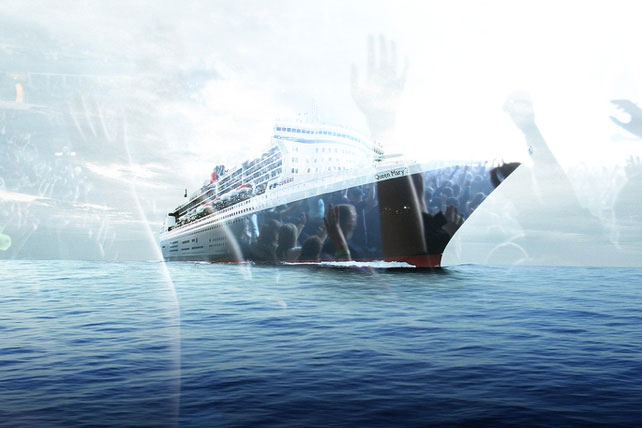Throughout the first half of the 20th century, New York harbor bustled with ocean liners transporting thousands of people between North America and Europe every week. Great ships like the Queen Mary and Normandie were celebrated as floating palaces, but very few passengers enjoyed their luxuries. Most who sailed on them were poor immigrants and refugees relegated to third-class accommodations. These ships served a highly utilitarian purpose—moving passengers and cargo from point A to point B. That’s why they were called “liners.”
But the glory days of the ocean liners began to fade in 1953 when a Comet roared across the Atlantic. The De Havilland Comet was the first commercial jetliner. The distance covered by an ocean liner in six days was traveled by a jetliner in six hours. Virtually overnight, the vast Atlantic ocean became “the pond.” By the 1960s, the great ships were being laid up or sold for scrap. Many predicted the passenger shipping business would never recover. They were wrong.
A handful of innovative ship owners developed a new way for their fleets to produce revenue: cruises. Rather than crossing the Atlantic from point A to point B, cruises sailed in a circuit, embarking and disembarking passengers from the same port. And their goal was not to transport passengers, but to get tourists to buy and consume more of the products and services onboard the ship. The shift from crossing to cruising was really a shift from transportation to consumption.
Because of this, over time, cruise lines sought to increase the number of entertainment options onboard their ships. This triggered a rapid increase in the size of vessels being built, each one incorporating more of the features vacationers wanted. As a result, many of today’s gargantuan cruise ships dwarf the ocean liners of the past—something no one would have predicted 50 years ago when passenger shipping was believed to be on its deathbed.
The ocean liner Titanic (1912) compared to the cruise ship Oasis of the Seas (2009).
Why am I talking about the history of the shipping industry? Well, I think it’s a helpful parallel for what’s happened in the American church over the last 40 years. Around the same time that jetliners were causing waves for the shipping industry, cultural changes were also rocking the church. Prior to the 1960s, most churches in America were small with a very utilitarian function—they transported people into communion with God by providing the basic necessities for living a Christian life.
But by the 60s and 70s, the Baby Boomers grew up and many stopped going to church. The culture had changed—secular values, youth culture and entertainment had taken root and the church could no longer compete. Traditional churches, built for utility, struggled. But like some ship owners at the time, entrepreneurial pastors began tinkering to see if a new purpose for the church could be found.












